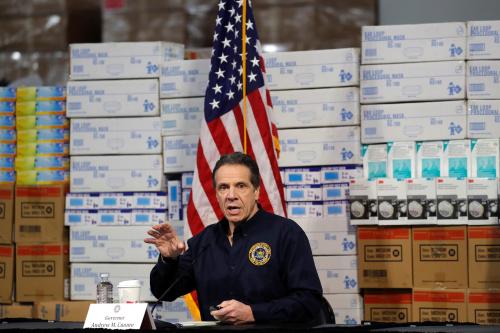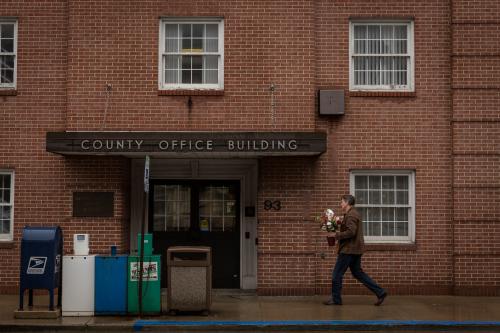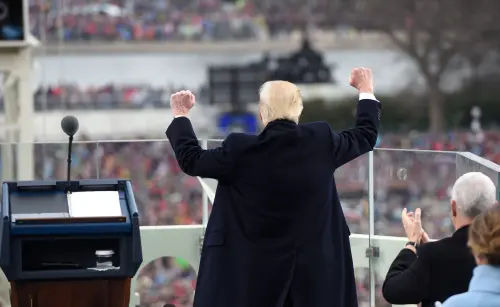As all 50 states start to reopen their economies, government officials face questions about their response to the coronavirus pandemic. While a vast majority of discourse focuses on the important health consequences resulting from variation in state restrictions, conflicting policies across the country highlight some key constitutional issues that remain unresolved as we move forward in this crisis.
The COVID-19 pandemic brought increasing attention to our federalist form of government. The traditional story of federalism recognizes that the national government can make policy in some areas, while the states reserve the right to regulate in other areas. However, as the pandemic has highlighted, things are not always that clear-cut. The constitutional boundaries between state and federal authority are increasingly difficult to ascertain. As a result of political decisions by both state and federal elected officials, today’s American government looks different than originally contemplated by the nation’s founders. Here are four developments in our federal system of government illuminated by COVID-19.
Governors’ executive powers have expanded
One of the Anti-Federalist critiques of the Constitution was that the presidency was a disguised monarchy that, in collaboration with the Senate, would rule the country tyrannically. The Federalists countered that, combined with separation of powers, the distribution of authority between the state and national governments would prevent executive power grabs.
However, over time, the executive branch at each level of government has grown in size and authority. National executive agencies now create policies that regulate Americans’ economic, social, and political activities, prompting Chief Justice John Roberts to muse that the current executive branch would leave the Framers “rubbing their eyes.” A similar expansion of executive power has occurred at the state level. A cycle of reform in state government has marked the past decades, prompted by a concerted effort to strengthen historically weak governorships.
This transfer of power to the executive is heightened in times of crisis. At the onset of an emergency, citizens look to executive officials to direct government action. Additionally, as a result of their deliberative nature, the legislative and judicial branches tend to play a more reactive role. We’ve seen this in both national and state responses to COVID-19. For example, while the Trump administration took its first actions in response to the pandemic in early February, Congress did not pass the CARES Act until late March. At the state level, only 29 state legislatures have passed legislation relating to the coronavirus, while every state governor has taken executive action.
National politicians look to governors for partisan wins
Even with an expanded executive branch, the national government simply does not have the resources to do everything it wants. As a result, it increasingly turns to the states to carry out important governmental tasks. Such reliance further develops and strengthens executive branch actors at the state level. This is particularly true in healthcare, where lines between state and federal policy are quite blurred.
How politicians engage this complicated relationship between the state and federal government is strategic—federalism has become an important tool in political negotiations. National political figures enact vague policies that allow for variation in state implementation, claiming credit for acting on important issues while shifting the responsibility for figuring out the details to the states. Not only does this strategy allow for some states to take minimal efforts in implementing federal policy, but it can enhance partisan conflict. President Trump’s actions over the past few months illustrate this point. When his administration began to respond to the crisis, issuing guidelines and emergency use authorizations, he used his relationships with various governors for partisan gain. In one of his more colorful statements on the issue, Trump tweeted “Tell the Democrat Governors that ‘Mutiny On The Bounty’ was one of my all time favorite movies. A good old fashioned mutiny every now and then is an exciting and invigorating thing to watch, especially when the mutineers need so much from the Captain.” Such comments suggest that political competition may no longer flow through the separation of powers or federalist system, but rather through political parties.
Thousands of jurisdictions administer elections
Of course, elections provide citizens with a way to comment on the policies that the political parties adopt. However, elections represent a classic example of how federalism presents the nation with new challenges. The decentralized process provided by the Elections Clause of the U.S. Constitution ensures that the regulation and administration of elections occur at the state level. While designed to enhance geographically-based representation, this decentralization results in tremendous variation in the legal frameworks that govern the electoral process. Because of how states delineate responsibility for elections, approximately 8,000 different jurisdictions administer American elections. This incredible number has led many to refer to election administration as “hyperfederalized.”
Such a system not only makes governing the electoral process complex, but also has profound implications for how administrators will implement and citizens will experience that framework in the pandemic. We have already seen it play out in the past few months, with more than 20 states postponing elections due to coronavirus and federal and state litigation arising over several states’ mail-in and absentee voting policies.
Accountability for responding to COVID-19 is complicated
Even if all citizens have equal opportunity to vote under comparable electoral rules, one could question whom citizens should hold accountable for COVID-19 policy. When the states and national government act in the same policy space, voters may not be able to discern whom to blame when things go poorly and to reward when things go well.
This accountability problem only amplifies when unelected administrators are thrown into the mix. For example, what if the Food and Drug Administration moves too quickly in approving a coronavirus vaccine that has harmful side-effects? The president will undoubtedly blame faceless bureaucrats in the “deep state,” state governors will blame the Trump administration (and likely the president himself) for fast-tracking dangerous drugs, and voters will be left wondering why government seems dysfunctional. As the 2020 presidential election approaches and voters begin to evaluate elected officials, the ability to hold politicians responsible for their actions is particularly important.
Ironically, the Framers anticipated that federalism would increase accountability and further the general welfare of American citizens. As we move forward in the coming months, whether our constitutional design furthers these goals remains to be seen.






Commentary
How the Constitution’s federalist framework is being tested by COVID-19
June 8, 2020